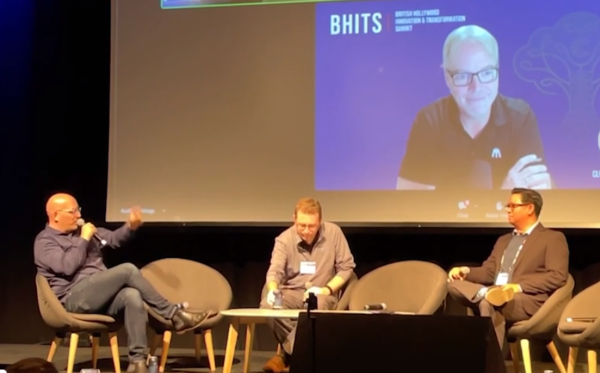M+E Europe

British HITS Panel: Data Centers Play a Key Role in the Fight Against Climate Change
Story Highlights
Data centers represent the new frontier when it comes to the global fight against climate change, according to industry experts who spoke during the panel session “Why Data Centers are the New Frontier in the Fight Against Climate Change” at the Nov. 15 British Hollywood Innovation & Transformation Summit (HITS) event in London.
Recent predictions state that the energy consumption of data centers is set to account for 3.2% of total global carbon emissions by 2025 and they could consume no less than a fifth of global electricity.
By 2040, storing digital data is expected to create 14% of the world’s emissions, around the same proportion as the U.S. does today.
While other industries have “totally embraced” green initiatives, the media and entertainment (M&E) sector has been slower to act, according to panel moderator Guy Finley, president and CEO of MESA.
“We probably could figure it out along the way,” Finley said. “Hollywood’s pretty good at figuring things out along the way but this has been going on for years in the background.”
The issue involves some of the “biggest companies in the world,” he said, pointing to Amazon Web Services (AWS) data center requirements. “Disney needs some servers, right? So does Paramount. So does BBC.”
Server usage is “integral and important to their business model and they need massive capacity because they’re absolutely exposed to the broader global population,” he added.
Infrastructure Masons Initiatives
Infrastructure Masons, a professional association for infrastructure executives and technical professionals, has been busy trying to drive member companies to green initiatives, according to Dean Nelson, its founder and chairman.
He pointed to his organization’s climate accord members, who he said have been “coming together to battle climate change.” There are over 9,000 people “participating globally right now” on that initiative, he said.
 “They represent over $150 billion worth of infrastructure projects across 131 different countries,” Nelson said. “They key is that it’s the builders of the digital age. When we come together as a professional association [that is] a non-profit, we unite on these different causes. So one of those is the climate accord, and that is where we brought companies together to tackle first off carbon neutrality as a first step towards net zero.”
“They represent over $150 billion worth of infrastructure projects across 131 different countries,” Nelson said. “They key is that it’s the builders of the digital age. When we come together as a professional association [that is] a non-profit, we unite on these different causes. So one of those is the climate accord, and that is where we brought companies together to tackle first off carbon neutrality as a first step towards net zero.”
His organization’s climate accord has 172 companies in it, including AWS, Cisco, Google, Meta and Microsoft, he said, noting the “combined market cap of these companies [is] over $6 trillion.”
“We can move things because with those companies, they’re going to now lead with their pocketbooks, their buying power,” he told attendees.
‘Everything Counts’
Sean Tajkowski, technical director at the Media & Entertainment Data Center Alliance (MEDCA), noted that he looks at the issue on a global basis and it “doesn’t matter how small you actually are – everything counts.”
He pointed out that includes “everything down to the smallest data centers [and] some of our micro data centers that we use within virtual production are just as important” as the hyperscale data centers Nelson discussed.
One important issue is that companies need to look at all types of materials that they’re using, along with their hourly operations, according to Tajkowski. They all “pertain to sustainability,” he said.
The problem, however, is, “I think a lot of people, especially in our industry, they just look at maybe diesel fuel and they’re not looking at what is the makeup of the studio, what [are] the products that the studio is using, what are the hourly power and water requirements of that studio?”
Sustainability is “not as plain and simple as aluminum cans and diesel fuel,” he stressed.
“I’m trying to bring a lot more awareness, being from the infrastructure world, to this climate change initiative,” he noted.
MEDCA is bringing some green resources to “people within Hollywood who don’t really realize that a lot of these resources are available,” he added.
Minimizing Scarce Materials
A key part of green M&E initiatives need to be focused on utilization and the “natural resources that we [use] to build our products, according to Jason Bautista, solutions architect, enterprise strategy and technology at Commscope.
“We hear about it all the time … about shortages and having a scarcity of certain mine materials in order to create products,” he noted. “And so when we look at that from a manufacturing perspective, it’s understanding: A. How do we maximize our product and the development of our product while also minimizing the impact of those scarce things in the environment for us to do that?”
Meanwhile, “as a manufacturer, the other side of the coin is that when we produce the product, we consume other resources like water and power and things like that,” Bautista explained.
Streaming’s Intangibility
“One of the things we very early on realized was streaming [is] a very ephemeral, intangible thing,” according to Dom Robinson, founder of Greening of Streaming, an organization created to address growing concerns about the energy impact of the streaming sector.
“We drive a lot of demand for technology services, for things that you can put on a table,” he said, explaining: “You can burn them, you can check out how much carbon they’ve got in them, and you can kind of assess how much carbon’s being extracted in the embedded emission cycle and so on. We don’t really have a direct input or control on that cycle. We create the demand for those products, so we become the tail that wags the dog as an industry.”
Yet the “streaming architects didn’t think about this stuff until” 2-3 years ago,” he said, adding: “We just assumed that everyone else around us,” including Infrastructure Masons, were “sorting that problem out for us,” he said.
So, the thought was: “As long as we bought the services we could get on and just deliver the streaming,” he said. “But as we’ve started to realize how much of that infrastructure we are driving, we have to stop and think about the architectures and we can’t just frivolously use energy.”
Meanwhile, he said: “I don’t think there’s a person ….. who really thinks in their heart that offsetting is solving a problem.” What is being used is also “not a hundred percent renewable” as some believe, he said.
Therefore, “green at that level is … becoming a badge to drive an emotion,” he said, explaining: “It doesn’t necessarily connect with what’s really happening.”
But greenwashing is “still a noble cause,” he argued. “I’d rather they were greenwashing than saying to hell with it, light it all up with diesel. At the end of the day, I’d rather they were trying to get that message across, however confused it is, however misinformed.
He went on to say: “What we’ve lacked is actually some pushback and say to the application designers, ‘design your services better, use these resources better.’ And, in fact, what’s happening is you see telcos just go, ‘well, there’s more demand so we’ll just grow, we’ll grow cleaner and greener; we’ll build our data centers cleaner and greener.”
Meanwhile, there is also “no pushback to say ‘do you actually need this much cashing, do you need this much data center, do you need this much usage?’”
He conceded that a “consumer doesn’t buy a 4K service to opt out of it.” But he added: “If you deliver them a 1K service and offer them a gold button option, you might on occasion get them to opt in and minimize their energy use. So those little bits of critical thinking need to cross the boundary between the fabric and the application design.”
To view the entire session, click here.
The British Hollywood Innovation & Transformation Summit, held in conjunction with the EIDR Annual Participant Meeting, was sponsored by Whip Media, GeoComply, Perforce, Signiant, and EIDR, was programmed under the guidance of the content advisors of the Hollywood IT Society, and was produced by MESA and the Hollywood IT Society (HITS).









